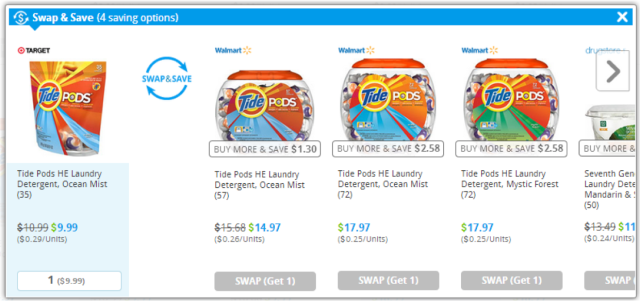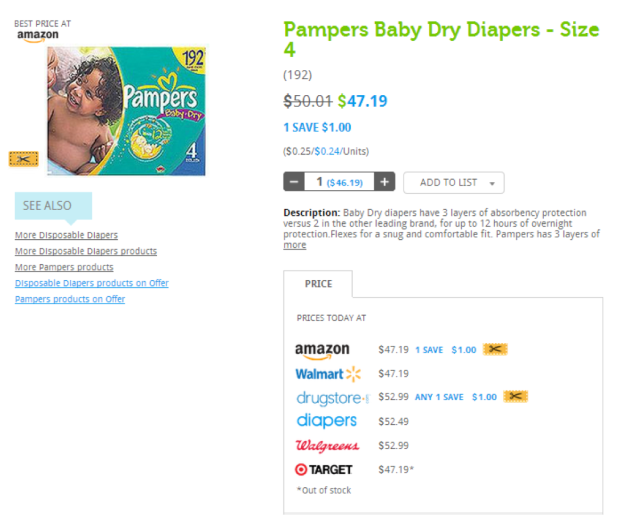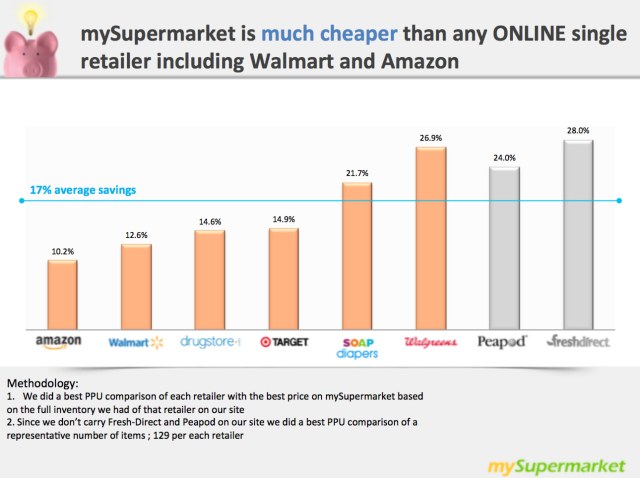On the heels of reports that Amazon is preparing to significantly expand its online grocery service AmazonFresh, grocery comparison shopping site mySupermarket is today bringing its service the U.S. Operating something like a Kayak for grocery and drugstore products, the new U.S. version of mySupermarket lets shoppers find the best prices across top stores, including Amazon, Walmart, Target, Costco, Walgreens, Diapers.com, Soap.com, and Drugstore.com.
mySupermarket was founded back in 2006, and now has offices in London, New York, Tel Aviv, and Tokyo. The company currently operates a U.K. version of the site which offers price comparisons across major European retailers including Tesco, Asda, Waitrose, Ocado, Sainsburys, Boots, Superdrug, Majestic and Virgin Wines. That business has 4 million monthly users, and sees average baskets of around $130.
Last April, mySupermarket raised a $10 million round of funding, with $7 million from media and ad giant WPP, and the rest from existing investors Greylock and Pitango, with the key goal of entering into the U.S. market.
Today, the company is making that debut with the official launch of mySupermarket.com. (The U.K. site is mySupermarket.co.uk.).
CEO Allon Bloch joined the company around five and half years ago, after previously co-founding Wix, because he believed there was an opportunity to change the way people shop online for small ticket items.
“When you buy a big-ticket item – a car or TV – you do a lot of research online, you ask people, and there are ways to do it,” he explains. “We want to make it really easy to shop [for small ticket items] and easy for you to understand the trade-offs on other options, bulk opportunities, or across different brands.”
The idea is that by comparing across not just brands – like consumers do while shopping a single store online or off – but also across stores, and combining that data with the ever-changing lineup of promotions and deals, mySupermarket can help consumers find the lowest available prices.
“People spend, on average, close to $1,000 per month buying these things, and you don’t really know what you’re paying for and you have little control and visibility into this,” Bloch says. “This is not an anti-retail play, it’s a pro-consumer play.”
On the e-commerce megastore, shoppers can browse across grocery categories (beverages, snacks, pantry, pets, etc.) as well as personal care and health items (mom and baby, beauty, etc.), in order to find out who has the best price. Users can drill down by category, brand-name and more, and sort results by relevance, price, popularity, or alphabetically. When viewing any of mySupermarket.com’s some 60,000 items, users can also add that item to their list or cart, share it across social networks, and view a chart of that item’s historical price changes. The site may also alert you if you’re buying something where it found a better value elsewhere.
After filling a cart with the best-priced items from your favorite brands, the real magic in mySupermarket is its universal checkout. You don’t have to go to each site you bought from and checkout individually – the service automatically splits your bill for you with each e-commerce store, while still making sure you have access to any special promotions or membership program discounts you would normally be able to use if shopping directly (e.g., Amazon Prime free shipping, discounts for new customers, etc.).
mySupermarket is not operating in partnership with the e-commerce sites users buy from, but has rather created its own proprietary technology which allows it to crawl those sites and pull down data, then adding its own images to accompany the items, and in time, nutritional info will be added, too. Also on the roadmap are plans for a mobile experience that would help to alert shoppers to promotions on their favorite items while shopping in a brick-and-mortar store.
Today the U.K. audience does more of its grocery shopping online (around 7 percent is online), while the U.S. is still hovering around 1 to 1.5 percent. “But it’s growing quite quickly in certain categories,” Bloch notes, “especially non-perishables.” And, he adds, as established companies like Amazon push forward into this market (with Amazon Fresh, for example), other players like Walmart will follow.
The company is not the first to attempt to aggregate pricing of online groceries and household goods from multiple sources – a startup called NetPlenish raised $1.9 million in seed funding last spring for a similar idea which would allow shoppers to buy from a variety of online merchants, including many that mySupermarket now indexes. But NetPlenish (now Shop Genius) has since pivoted to offer a browser extension for price comparisons and coupons instead.
“Wherever we launch, people try to copycat us – including our typos – but they never survive because doing this is tough,” Bloch claims. “And we still have a long ways to go on mobile,” he admits. The company’s app, expected in the weeks ahead, will allow brands to communicate with consumers who want to hear from them – alerting to price drops on favorite items a consumer is tracking, for instance, or reminding you it’s time to replenish one of your staples.
“We want to help people shop wherever they want to shop,” says Bloch.
The mySupermarket.com website is live now, and offers free shipping for baskets over $75.00.




